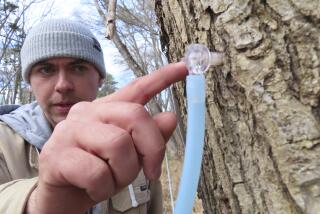Boysen and other hybrid blackberries
Boysen: The standard of quality in hybrid blackberry flavor, rich and distinctive; fruit is large, soft, juicy and dark purple when fully ripe. Originated as a cross of Logan (see below) with an Eastern dewberry (trailing blackberry) such as Lucretia or Mayes (a.k.a. Austin). Supposedly bred by Rudolph Boysen in the early 1920s at John Lubben’s farm near St. Helena in Napa County, and later brought to Southern California, where it was popularized by Walter Knott. Grown in the 1950s on several thousand acres in California, where fewer than 70 acres now remain; Oregon still has 600 acres, mostly for processing (production was 3 million pounds in 2009). The California season starts in late May and runs through June, sometimes into early July if it doesn’t get too hot.
Kotata: A cross of Pacific x Boysen with Jenner-1 x Eldorado, originated by George F. Waldo of the U.S. Department of Agriculture in Corvallis, Ore., introduced in 1984. The plant is more winter-hardy and the fruit is firmer than Marion, and the season is later. It’s the third most important hybrid blackberry in the Northwest (600 acres, 3.1 million pounds). There are just a few scattered plantings in California, where the fruit is not very well adapted, but the flavor from well-ripened fruit can be startlingly intense.
Logan: Originated from a cross made in 1881 by Judge James H. Logan in Santa Cruz, Calif., of Red Antwerp raspberry and the Aughinbaugh variety of a native Pacific dewberry species, Rubus ursinus. Although rather tart for eating fresh, it was widely grown in the early 20th century for wine, juice and preserves, and was important as a parent of Boysen. It was grown on about 4,000 acres in the United States in the 1920s; it’s now rare in California but still cultivated on fewer than 30 acres in Oregon, with production at just 50,000 pounds. Logan drinks are a much appreciated local specialty near Buffalo, N.Y.
Marion: The industry standard for processing, grown on about 4,000 acres in Oregon’s Willamette Valley (production is 25 million pounds), primarily by Russian Orthodox Old Believers, and harvested mechanically at night. It’s a cross of Olallie and Chehalem, introduced in 1956 by George F. Waldo of the USDA. The plants are thorny and not well adapted to Southern California, but the fruit has remarkably rich, intense flavor. Its season is a week or more later than Boysen’s.
Nectar: Originated by Howard G. Benedict in El Monte and introduced in 1937. Originally said to have been a seedling of Young, but later thought to be a chimera (mutation) of Boysen. The fruit is supposed to be larger than Boysen, and many claim it is sweeter. It’s rare today but still occasionally grown by home gardeners and for farmers markets.
Newberry: A complex hybrid blackberry involving Boysen, Marion, Logan and many other varieties, bred by Chad E. Finn of the USDA in Corvallis, Ore., and officially introduced this year. Originally selected for processing, it has seemed more promising for fresh sales, because the berries, somewhat redder and sweeter than Boysen, do not leak juice as readily. It is grown on 20 acres by Paul and Gayle Willems and two of their sons in Kingsburg, south of Fresno, and marketed as “Ruby Boysen” at their Berry Lady farm stand, and at Southern California retail stores.
Olallie: A cross of Black Logan and Young introduced by George F. Waldo of the USDA in 1950, it proved too cold-tender to do well in Oregon. But it is well adapted to the warm winters of California, where it was a common variety for processing and shipping from the 1960s to the 1990s, and is still cultivated for local and farmers market sales. It has very good flavor if picked ripe but is not as rich as Boysen or Marion. Its season is about a week earlier than Boysen.
Silvan: Originated in Victoria, Australia, as a cross of Marion and a numbered blackberry selection, from seed supplied by George F. Waldo of the USDA, introduced in 1984. It’s the second leading commercial processing variety in Oregon, a heavy bearer (800 acres, 8 million pounds), but very minor in California. Softer than Marion, it has good flavor but isn’t as aromatic. About a week earlier than Boysen.
Tayberry: Cross of Aurora blackberry and a numbered raspberry, bred by Derek L. Jennings of the Scottish Crop Research Institute, introduced in 1980. Generally used for preserves, it has excellent flavor, but unless it is very ripe, it is too tart for eating fresh, for most palates. Grown on a small scale in the Northwest and by a very few farms in California.
Young: A large, sweet hybrid berry, similar to Boysen but milder in flavor. A cross of Mayes (Austin) dewberry and Phenomenal that originated in Morgan City, La., with Byrnes M. Young; selected about 1905 but not introduced until 1926. It was the most cultivated bush berry in California in the 1930s, raised on 991 acres in 1940. It soon afterward was supplanted by Boysen and now is rarely grown but still occasionally found at farmers markets.
More to Read
Eat your way across L.A.
Get our weekly Tasting Notes newsletter for reviews, news and more.
You may occasionally receive promotional content from the Los Angeles Times.






